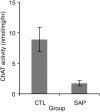Hippocampal acetylcholine depletion has no effect on anxiety, spatial novelty preference, or differential reward for low rates of responding (DRL) performance in rats
- PMID: 26214215
- PMCID: PMC4516321
- DOI: 10.1037/bne0000072
Hippocampal acetylcholine depletion has no effect on anxiety, spatial novelty preference, or differential reward for low rates of responding (DRL) performance in rats
Abstract
We investigated the role of the septo-hippocampal cholinergic projection in anxiety, spatial novelty preference, and differential reward for low rates of responding (DRL) performance. Cholinergic neurons of the rat medial septum (MS) and the vertical limb of the diagonal band of Broca (VDB) were lesioned using the selective immunotoxin, 192 IgG-saporin. Rats were then tested on several behavioral tests previously shown to be sensitive to either (a) hippocampal lesions or (b) nonselective MS/VDB lesions which target both cholinergic and γ-aminobutyric acid (GABA)-ergic projections, or both. Saporin lesions substantially reduced hippocampal cholinergic innervation, resulting in an absence of acetyl cholinesterase staining and markedly reduced choline acetyltransferase activity (mean reduction: 80 ± 5%; range: 50-97%). However, the saporin-lesioned rats did not differ from control rats in any of the behavioral tests. Thus we found no evidence from these lesion studies that the septo-hippocampal cholinergic projection plays an essential role in anxiety, spatial novelty preference, or DRL.
(c) 2015 APA, all rights reserved).
Figures




Similar articles
-
Impaired and spared cholinergic functions in the hippocampus after lesions of the medial septum/vertical limb of the diagonal band with 192 IgG-saporin.Hippocampus. 2004;14(2):170-9. doi: 10.1002/hipo.10160. Hippocampus. 2004. PMID: 15098723
-
Septal cholinergic neurons suppress seizure development in hippocampal kindling in rats: comparison with noradrenergic neurons.Neuroscience. 2001;102(4):819-32. doi: 10.1016/s0306-4522(00)00499-1. Neuroscience. 2001. PMID: 11182245
-
Sexually dimorphic effects of hippocampal cholinergic deafferentation in rats.Eur J Neurosci. 2004 Dec;20(11):3041-53. doi: 10.1111/j.1460-9568.2004.03739.x. Eur J Neurosci. 2004. PMID: 15579159
-
Involvement of cholinergic neuronal systems in intravenous cocaine self-administration.Neurosci Biobehav Rev. 2004 Jan;27(8):841-50. doi: 10.1016/j.neubiorev.2003.11.002. Neurosci Biobehav Rev. 2004. PMID: 15019433 Review.
-
The transsynaptic regulation of the septal-hippocampal cholinergic neurons.Life Sci. 1983 Jan 17;32(3):165-79. doi: 10.1016/0024-3205(83)90028-0. Life Sci. 1983. PMID: 6185815 Review.
Cited by
-
Intrahippocampal Adeno-Associated Virus-Mediated Overexpression of Nerve Growth Factor Reverses 192IgG-Saporin-Induced Impairments of Hippocampal Plasticity and Behavior.Front Neurosci. 2021 Nov 15;15:745050. doi: 10.3389/fnins.2021.745050. eCollection 2021. Front Neurosci. 2021. PMID: 34867156 Free PMC article.
-
Cholinergic modulation of sensory processing in awake mouse cortex.Sci Rep. 2021 Sep 1;11(1):17525. doi: 10.1038/s41598-021-96696-8. Sci Rep. 2021. PMID: 34471145 Free PMC article.
-
Novel Projections to the Cerebrospinal Fluid-Contacting Nucleus From the Subcortex and Limbic System in Rat.Front Neuroanat. 2020 Aug 20;14:57. doi: 10.3389/fnana.2020.00057. eCollection 2020. Front Neuroanat. 2020. PMID: 32973466 Free PMC article.
-
Silica nanoparticles (SiNPs) derived from melon seed husk ameliorate Ni/Al mixture-mediated cognitive impairment in rats.J Med Life. 2024 Sep;17(9):856-867. doi: 10.25122/jml-2024-0019. J Med Life. 2024. PMID: 39628974 Free PMC article.
-
The effect of nerve growth factor on supporting spatial memory depends upon hippocampal cholinergic innervation.Transl Psychiatry. 2021 Mar 15;11(1):162. doi: 10.1038/s41398-021-01280-3. Transl Psychiatry. 2021. PMID: 33723225 Free PMC article.
References
Publication types
MeSH terms
Substances
Grants and funding
LinkOut - more resources
Full Text Sources
Other Literature Sources
Medical

